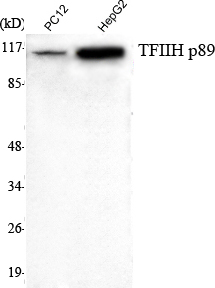TFIIH p89 Monoclonal Antibody
- Catalog No.:YM1106
- Applications:WB
- Reactivity:Human;Mouse;Rat;Bovine;Dog
- Target:
- TFIIH
- Fields:
- >>Basal transcription factors;>>Nucleotide excision repair
- Gene Name:
- ERCC3
- Protein Name:
- TFIIH basal transcription factor complex helicase XPB subunit
- Human Gene Id:
- 2071
- Human Swiss Prot No:
- P19447
- Mouse Gene Id:
- 13872
- Mouse Swiss Prot No:
- P49135
- Rat Gene Id:
- 291703
- Rat Swiss Prot No:
- Q4G005
- Immunogen:
- Purified recombinant human TFIIH p89 (C-terminus) protein fragments expressed in E.coli.
- Specificity:
- TFIIH p89 Monoclonal Antibody detects endogenous levels of TFIIH p89 protein.
- Formulation:
- Liquid in PBS containing 50% glycerol, 0.5% BSA and 0.02% sodium azide.
- Source:
- Monoclonal, Mouse
- Dilution:
- WB 1:1000 - 1:2000. Not yet tested in other applications.
- Purification:
- Affinity purification
- Concentration:
- 1 mg/ml
- Storage Stability:
- -15°C to -25°C/1 year(Do not lower than -25°C)
- Other Name:
- ERCC3;XPB;XPBC;TFIIH basal transcription factor complex helicase XPB subunit;Basic transcription factor 2 89 kDa subunit;BTF2 p89;DNA excision repair protein ERCC-3;DNA repair protein complementing XP-B cells;TFIIH basal transcripti
- Molecular Weight(Da):
- 89kD
- Background:
- This gene encodes an ATP-dependent DNA helicase that functions in nucleotide excision repair. The encoded protein is a subunit of basal transcription factor 2 (TFIIH) and, therefore, also functions in class II transcription. Mutations in this gene are associated with Xeroderma pigmentosum B, Cockayne's syndrome, and trichothiodystrophy. Alternative splicing results in multiple transcript variants. [provided by RefSeq, Dec 2014],
- Function:
- disease:Defects in ERCC3 are a cause of trichothiodystrophy photosensitive (TTDP) [MIM:601675]. TTDP is an autosomal recessive disease characterized by sulfur-deficient brittle hair and nails, ichthyosis, mental retardation, impaired sexual development, abnormal facies and cutaneous photosensitivity correlated with a nucleotide excision repair (NER) defect. Neonates with trichothiodystrophy and ichthyosis are usually born with a collodion membrane. The severity of the ichthyosis after the membrane is shed is variable, ranging from a mild to severe lamellar ichthyotic phenotype. There are no reports of skin cancer associated with TTDP.,disease:Defects in ERCC3 are the cause of xeroderma pigmentosum complementation group B (XP-B) [MIM:610651]; also known as xeroderma pigmentosum II (XP2) or XP group B (XPB) or xeroderma pigmentosum group B combined with Cockayne syndrome (XP-B/CS). Xeroder
- Subcellular Location:
- Nucleus.
- Expression:
- Adipose tissue,Epithelium,Placenta,
- June 19-2018
- WESTERN IMMUNOBLOTTING PROTOCOL
- June 19-2018
- IMMUNOHISTOCHEMISTRY-PARAFFIN PROTOCOL
- June 19-2018
- IMMUNOFLUORESCENCE PROTOCOL
- September 08-2020
- FLOW-CYTOMEYRT-PROTOCOL
- May 20-2022
- Cell-Based ELISA│解您多样本WB检测之困扰
- July 13-2018
- CELL-BASED-ELISA-PROTOCOL-FOR-ACETYL-PROTEIN
- July 13-2018
- CELL-BASED-ELISA-PROTOCOL-FOR-PHOSPHO-PROTEIN
- July 13-2018
- Antibody-FAQs
- Products Images

- Western Blot analysis using TFIIH p89 Monoclonal Antibody against PC12, HepG2 cell lysate.



